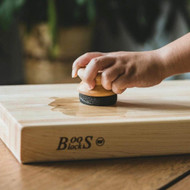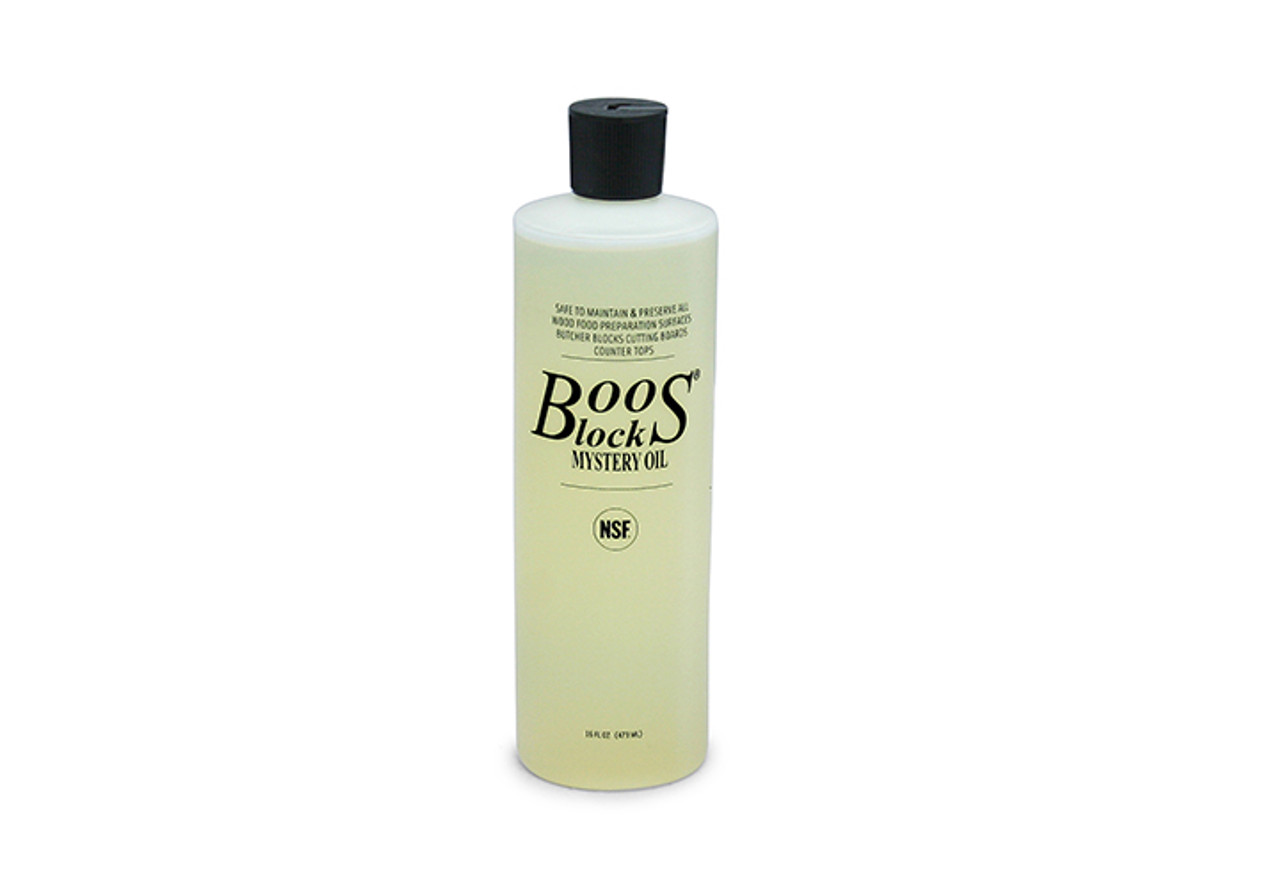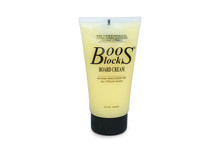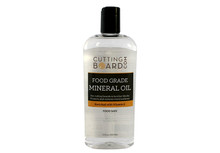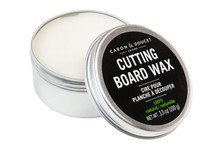What Type of Oils are Safe to Use on Your Cutting Board
Posted by Peter Webb on 17th Oct 2024
Our Recommendations
We stand behind these selections 100% and they are a collection of the safest and most effective products available. Read on for more information on why they are recommended!
-
$14.95121
-
$12.9586
-
$11.95$9.95142 -
$13.95$11.9536
There is some conflicting information regarding which oils and substances are appropriate to safely maintain cutting boards or butcher blocks. This guide will help identify which products you should use to keep your board looking beautiful for years to come. All of the products we sell on CuttingBoard.com are completely food-safe.
Safe and Recommended
Mineral Oil
Mineral oil (sometimes called liquid paraffin) is a non-toxic, non-drying product derived from petroleum that is colorless, odorless, and flavorless. Its properties prevent water absorption, which makes FDA approved food-grade mineral oil a popular choice for wooden kitchen items such as wooden spoons, bowls, and, of course, cutting boards and butcher blocks. The key word here is food-grade, as there are types of mineral oils that are not safe for human consumption; these are often used as lubricants for machinery or found in auto or hardware stores.
If you are worried about selecting the right mineral oil, any products labeled white mineral oil are considered food safe, as these are refined to a certain degree past other oils. Always make sure to carefully read the product's labeling if you are unsure about its proper use. The safest route of course is to buy a mineral oil specifically blended for use in cutting boards such as our Food Grade Mineral Oil.
Regular application of mineral oil will prevent cutting boards from becoming dry and brittle, which can cause a cracked board. A board that is treated with oil also prevents liquids from penetrating the board, which is often the source of germs and bacteria.
Beeswax
Beeswax is also a popular choice for cutting board maintenance. It's a natural wax produced in the bee hives of honey bees and has a variety of applications. Use beeswax to hydrate, shine, and waterproof a cutting board.
You can buy readily made products such as Boos Board Cream with Beeswax or Clapham's Beeswax Butcher Block Finish. To make your own: melt 1 part beeswax and combine with 4 parts mineral oil in a pot to make your own blend. We recommend Big Dipper Wax Works 100% Beeswax.
In addition, we now carry a pure plant based, vegan cutting board wax, made from rice and coconut. This is a good option for those allergic to bee pollen or propolis (beeswax) or simply those that are strictly vegan.
Coconut Oil
Coconut oils have recently become highly popular for a variety of purposes, especially in beauty, because it is rich in saturated fats that are good for skin health. Unfortunately, all fats exposed to air eventually go rancid and coconut oil is not immune (even though some bloggers claim otherwise). However, a select group of coconut oils are refined using a refractionation process, also known as distilling. During this distillation process, coconut oil is separated so that the long-chain triglycerides (LCT) are removed and only the medium chain triglycerides (MCT) are left. This leaves an almost pure oil that has a much longer shelf life and is superior to most other oils for treating not just cutting boards, but your kitchen utensils, salad bowls, countertops and more.
Caron and Doucet's Cutting Board Oil is a coconut based cutting board oil that is food safe and has added lemon oil essence for antibacterial purposes. Remember that not all coconut oils should be considered food safe!
Carnauba
Also known as Brazilian wax, it is derived from the leaves of a palm tree native to Brazil. Sometimes called “the queen of waxes,” carnauba is prized for its glossy finish and water resistance and is often used in automobile waxes, polishes, cosmetics, and even dental floss. Like beeswax, commercially available cutting board creams and oils often contain a mixture or carnauba, beeswax, and mineral oil. Our Natural Wood Wax is an excellent blend to try.
Baking Soda
What can't baking soda be used for? You can safely use baking soda to remove stubborn stains from a cutting board or butcher block. Sprinkle baking soda over the offensive spot and rub with a cloth, brush, or sponge dipped in hot water.
Lemon Juice
If your board begins to smell, one of the easiest tricks is to cut a lemon in half and run it across the entire surface. The ascorbic acid in the lemon both reacts with and oxidizes organic material (bacteria and fats) that are the cause of smells and stains. The natural lemon oil also forces any soluble materials to be removed as well.
Use With Caution
Tung Oil
An oil derived from the tung tree originating in southern China, it is very popular in woodworking for creating a satin look with a slight golden tint. However, there are two reasons to be cautious: 1) some people are terribly allergic to tung oil as it is made from a nut tree. 2) The name “tung oil” is often used by paint and varnish manufacturers as a generic name for a product that contains a small amount of oil or provides a similar finish. Be cautious of tung oil varnishes and paints that very likely contain toxic chemicals not meant for human consumption. If you use tung oil, look for 100% pure tung oil.
Linseed Oil
This oil is obtained by pressing the flax plant. Raw linseed oil is safe for human consumption. However, boiled linseed oil is heated and treated with chemicals that make it toxic for humans. Linseed oil is prized among woodworkers for its water-repelling properties and luster after being applied. However, as an organic oil, rancidification is a possible drawback. Rancidity is a common problem with all organic oils caused by hydrolysis and/or autoxidation of fats. For us humans, this means a rank, unpleasant smell or taste lingering in the board. Having said this, linseed oil does not go rancid as quickly as other oils, and some people say it doesn't go rancid at all. This could very well be a case of using linseed oil only if you know the source and quality.

Walnut Oil
Extracted from English walnuts, walnut oil is similar to linseed oil with a few added drawbacks and benefits. First, it comes from a nut, so be cautious with allergic family members or guests. It is also very expensive, and like linseed oil, will eventually go rancid. The one benefit is that walnut oil smells great!
Bleach
Bleach quickly reacts with microbial cells to denature and destroy many pathogens. High levels of bleach are toxic to humans, but the good news is that a diluted bleach solution is safe for you and your cutting board. Add one teaspoon of bleach to one quart of water and flood the board. Rinse with hot water afterward and then towel try. By no means should you use undiluted bleach on your cutting board as this is an unsafe concentration and could also discolor your board. Most importantly, never soak your board in any bleach and water mix.
Not Recommended
Vegetable Oils
Olive oil, corn oil, and sunflower oil, should never be used to maintain a cutting board or butcher block. These oils experience rancidification – a process that yields a rank smell and unpleasant taste. As a cutting board touches your food, substances that can turn rancid should be avoided. Food should always be tasty!
Varnish
A transparent, hard, protective finish or film used in woodworking, varnish is also called shellac or lacquer. While these products protect wood and provide a beautiful finish, they are inappropriate for maintaining a cutting board. Most varnishes are made from a solvent that preserves the liquid in the container and evaporates as the finish dries, leaving a binder or resin that protects the wood's surface. This residual resin will chip and peel off when exposed to sharp objects like knives. This is problematic for two reasons: 1) the substances in the varnish can be toxic to humans and 2) having little bits of varnish in food can ruin taste and aesthetic appeal.
Rubbing Alcohol
When cutting boards and butcher blocks are not properly maintained they can become dry and cracked. Rubbing alcohol, while a great disinfectant, is extremely drying. Using it on wood is counterproductive to maintenance. To disinfect, use a diluted bleach solution or soap instead.
For more information on how to safely upkeep and sanitize your cutting board, read our guide on how to oil and maintain a cutting board.

